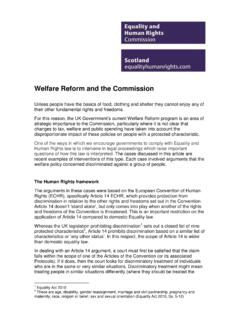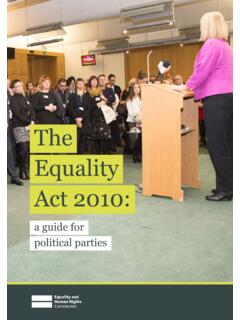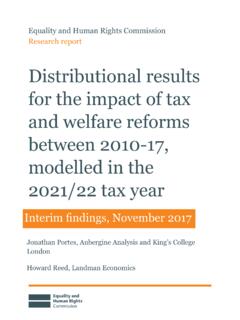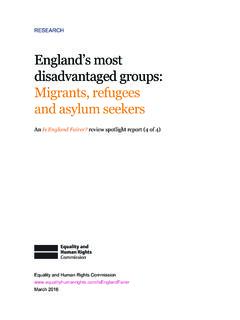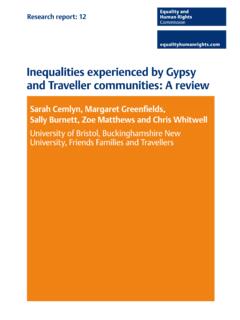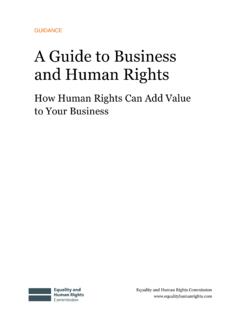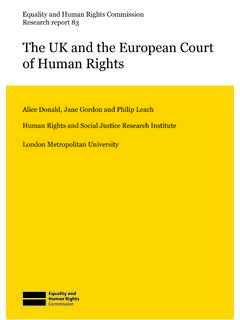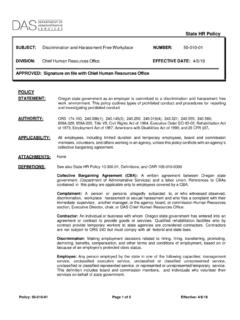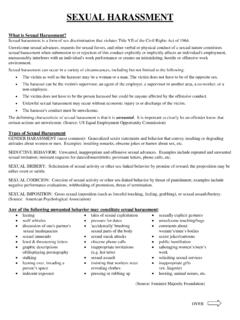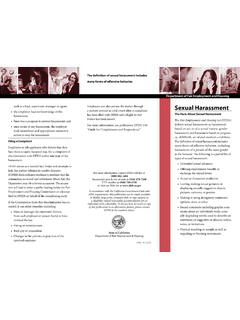Transcription of Sexual Harassment and the Law covers2b
1 Equality and Human Rights CommissionSexual Harassment and the law: Guidance for employersSexual Harassment occurs when a person engages in unwanted conduct of a Sexual nature that has the purpose or effect of: Sexual Harassment is unlawful under the Equality Act 2010. Unwanted conduct of a Sexual nature Includes a wide range of behaviour, such as: - Sexual comments or jokes - displaying sexually graphic pictures, posters or photos - suggestive looks, staring or leering - propositions and Sexual advances - making promises in return for Sexual favours - Sexual gestures - intrusive questions about a person s private or sex life, and discussing your own sex life - Sexual posts or contact on social media - spreading Sexual rumours about a person - sending sexually explicit emails or text messages - unwelcome touching, hugging, massaging or kissing - criminal behaviour, including Sexual assault, stalking, indecent exposure and offensive communications.
2 An individual can experience unwanted conduct from someone of the same or different sex. The recipient of the behaviour decides whether or not it is unwanted. Unwanted conduct can be one-off. It does not need to be repeated to constitute Sexual Harassment . Unwanted conduct does not need to be directed at a person. It can be witnessed or overheard. It does not matter whether the conduct is acceptable to others or is common in the person s work environment. Sexual interaction that is invited, mutual or consensual is not Sexual Harassment because it is not unwanted. Sexual conduct that has been welcomed in the past can become is Sexual Harassment ?violating someone s dignity orcreating an intimidating, hostile, degrading, humiliating or offensive environment for or effect If unwanted conduct is intended to violate a person s dignity or create an offensive environment, it is does not matter whether it has that effect on the person.
3 If unwanted conduct is not intended to cause distress, it can still have the effect of violating a person s dignity or creating an offensive dignity or creating an intimidating, hostile, degrading, humiliating or offensive environment Whether or not unwanted Sexual conduct violates a person s dignity or creates an offensive environment, depends on the victim s perspective and whether their reaction is reasonable in all the circumstances. People have different reactions to Sexual conduct. Behaviour that might appear harmless to one person can be more serious to another. Factors that affect the creation of an offensive environment include the relative power, seniority, age, race and cultural background of the people involved. A person imitates a Sexual act at work that makes a colleague feel degraded. An employer asks one of her workers if the worker is having sex with his boyfriend, which intimidates and humiliates him.
4 A hotel manager propositions one of his workers. She rejects his advances and he then refuses her a promotion. An employer displays a screensaver of a topless woman, which creates an offensive environment for other workers. A man overhears a female colleague being subjected to sexually abusive language, and this causes him offence. A manager puts his hand up his assistant s skirt during the office Christmas party. An employee has had a relationship with his boss. When the employee ends the relationship, his boss spreads rumours about his Sexual preferences at work. A shop assistant is repeatedly subjected to comments about her appearance by a customer. The shop owner does not take any steps to prevent the situation from happening of Sexual harassment3 You have a duty of care to protect your workers and you will be legally liable for Sexual Harassment in the workplace if you have not taken reasonable steps to prevent it.
5 Sexual Harassment is prohibited in all workplace contexts and related activities, including at office functions and parties, on training courses and at conferences. Sexual Harassment can be perpetrated by other workers and non-workers, including contractors, agency staff, clients or are no minimum requirements you can rely upon to demonstrate that you have taken reasonable steps to protect your workers, but all employers will be expected to have in place: an anti- Harassment policy that is communicated to workers and is effectively implemented, monitored and reviewed an appropriate procedure for reporting Harassment , protecting victims of Harassment and taking action if Harassment essential elements of an anti- Harassment policy include: a commitment to a zero-tolerance approach to Sexual Harassment a statement that Sexual Harassment is unlawful a clear definition of Sexual Harassment with examples relevant to the employer s working environment defined reporting channels for staff who wish to report Harassment a range of approaches for dealing with Harassment from informal resolution to formal disciplinary process a range of appropriate consequences and sanctions if Harassment occurs a prohibition on victimisation or retaliation against a complainant information about support and advice services.
6 Employers obligations What should an anti- Harassment policy contain? 4 Implementation of anti- Harassment policies is crucial to the creation of a safe and positive workplace environment. If a policy is not properly implemented, you are likely to be liable for failing to take reasonable steps to prevent Harassment . Effective implementation of an anti- Harassment policy includes: anti- Harassment training for all staff and the opportunity for ongoing reflection in the workplace verbal communication of the policy to all new staff through your usual induction processes discussion and reinforcement of the policy at staff meetings or through your usual line management processes translation of the policy for a linguistically diverse workforce if necessary evaluation of Harassment in the workplace through regular staff surveys on dignity at work where these are in can choose to deal with Sexual Harassment complaints through your existing grievance policy or through your anti- Harassment policy.
7 However, you should be aware that complaints of Sexual Harassment are often very sensitive and complex. Anybody dealing with Sexual Harassment complaints should receive specialist grievance process should: address any complaint in a fair and timely manner provide the opportunity for quick and informal resolution of less serious complaints set out the investigation process in detail state that disciplinary action up to and including dismissal may be taken under your disciplinary procedure if a complaint of Sexual Harassment is upheld state that the alleged perpetrator may be suspended during the investigation as a precaution for the protection of the complainant or to prevent interference in the investigationHow should the policy be implemented? How should Sexual Harassment complaints be handled? 5 ensure the confidentiality of employees, subject to any requirement to involve external agencies respect the principles of procedural fairness offer formal support to the complainant, including counselling in serious cases give a guarantee that the complainant will not be disadvantaged by making the complaint make adjustments to enable the complainant to participate in the disciplinary process without fear of can be an overlap between behaviour that constitutes Sexual Harassment and criminal offences, including Sexual assault, indecent exposure, stalking and offensive communications.
8 If you believe that a criminal offence may have been committed, you should advise the victim to report the matter to the police as soon as possible and give them appropriate support. In cases where the police are involved, you should liaise with the police regarding the disciplinary process and take advice on how to conduct a fair you believe there is an ongoing risk of serious harm to an individual, you should contact the police and inform the victim that you have done behaviour 6 ContactsThis publication and related equality and human rights resources are available from the Commission s website. For advice, information or guidance on equality, discrimination or human rights issues, please contact the Equality Advisory and Support Service, a free and independent 0808 800 0082 Textphone 0808 800 0084 Hours 09:00 to 19:00 (Monday to Friday) 10:00 to 14:00 (Saturday)Post FREEPOST EASS HELPLINE FPN6521 Questions and comments regarding this publication may be addressed to: The Commission welcomes your formatsFor information on accessing a Commission publication in an alternative format, please contact: 2017 Equality and Human Rights Commission Published December 20177 You can download this publication 2017 Equality and Human Rights Commission Published December 2017
